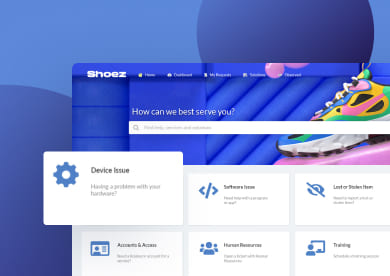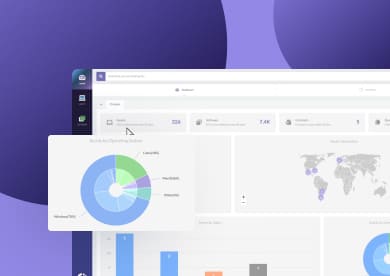Let’s be honest: IT never really gets a break. It’s constantly chasing new trends, responding to unexpected issues, and racing to stay ahead. That’s what makes it exciting — but also incredibly complex. And that’s exactly why staying on top of today’s IT challenges matters. The sooner you know what’s coming, the better you can prepare.
In this article, we’re breaking down the most pressing IT challenges businesses face in 2025. No fluff, no vague predictions — just the real obstacles standing in the way of progress (and how to start thinking about them).

The biggest IT challenges in 2025
Today’s IT teams are juggling more than just technical issues. Here’s a rundown of the most critical IT challenges organizations are facing in 2025:
- Cybersecurity threats keep escalating
- Compliance is becoming more complex
- Cloud costs are spiraling
- Digital transformation isn’t slowing down
- Data management is getting harder
- AI and automation are reshaping workflows
- Legacy systems are holding you back
- Skill gaps are widening
- Talent retention is a growing struggle
- Communication gaps hurt productivity
- IT budgets aren’t keeping up
- Vendor risk is now everyone’s problem
- Integrating new technologies is a full-time job
- Remote and hybrid work complicates everything
- Future-proofing feels like chasing a moving target
1. Cybersecurity threats keep escalating
Cybersecurity remains one of the top IT challenges in 2025 — and it’s only getting more complex. From AI-powered phishing to deepfake scams and endpoint vulnerabilities, the attack surface is expanding fast. IT teams aren’t just dealing with tools and tech; they’re battling creativity and unpredictability.
"You can't prevent a cyber attack. What you can do is make it harder. But that’s a people issue, a practice issue, and a technology issue."
David Moskowitz, DVMS Institute
To stay ahead, organizations must treat security as a continuous practice (not a one-time setup). That means testing systems, segmenting networks, training people, and adapting as fast as attackers do.
2. Compliance is becoming more complex
As global regulations around data privacy, cybersecurity, and AI evolve, compliance has become a constantly shifting target. Frameworks like GDPR, HIPAA, and the NIST Cybersecurity Framework demand more than just documentation. They require active governance, cross-functional collaboration, and continuous monitoring.
This growing complexity makes compliance one of the most pressing IT challenges in 2025. Building processes that can scale and adapt includes tracking regulatory changes, managing risk across vendors and departments, and embedding compliance into every stage of service delivery—before audits, not after.
3. Cloud costs are spiraling
Cloud adoption is nearly universal at this point. But managing the associated costs is far from simple. As more teams experiment with AI workloads, containerized apps, and multicloud strategies, cloud bills are ballooning in unpredictable ways.
What makes this an urgent IT challenge is the pressure to balance innovation with fiscal discipline. CIOs are being asked to deliver value fast while keeping budgets in check—often without full visibility into usage or ROI. Without proper governance, cloud investments can spiral into technical debt, wasted resources, and budget cuts that hurt long-term strategy.
4. Digital transformation isn’t slowing down
Digital transformation is now a permanent state of change. Businesses are expected to continuously modernize their systems, digitize workflows, and adopt new technologies to stay competitive. But that pace can be overwhelming, especially for organizations dealing with siloed systems, legacy processes, and internal resistance.
The challenge lies in execution. Without a clear strategy and proper coordination, transformation efforts often result in fragmented tools, technical debt, or initiatives that fail to deliver real value. IT teams are under pressure to not only lead the change but also make sure it's scalable, secure, and aligned with business goals.

5. Data management is getting harder
The volume of data organizations generate today is staggering — and it’s only increasing. From user activity and system logs to customer records and IoT device data, managing it all has become a serious challenge. Storing it is one thing; classifying, securing, and extracting value from it is another.
Poor Data Management can lead to compliance issues, inefficient operations, and missed business insights. IT teams must ensure that data is accurate, accessible, and governed across systems, departments, and vendors. That requires proper architecture, ownership, and tools for visibility and control.
6. AI and automation are reshaping workflows

AI is transforming IT operations. But while the potential is massive, the path to value is still unclear for many teams. There's pressure to "have an AI strategy," yet most IT leaders are still figuring out the basics: where to apply it, how to prepare their data, and how to avoid bias or hallucinations.
“IT leaders are being asked for AI results and roadmaps, often before they’ve even had a chance to understand what an AI strategy should look like.”
Ariel Gesto, CEO at InvGate
This disconnect is what makes AI adoption such a challenge. It’s not just about using the latest tools — it’s about navigating uncertainty, setting realistic expectations, and ensuring that AI empowers teams rather than replacing them.
7. Legacy systems are holding you back
Legacy infrastructure continues to be one of the biggest barriers to agility. Outdated hardware, unsupported software, or heavily customized platforms can prevent teams from integrating modern tools or scaling operations. In many cases, these systems are still critical to day-to-day operations, making them hard to retire.
The challenge lies in balancing stability with modernization. IT teams must manage the risks of aging systems—such as security vulnerabilities and performance issues—while building a plan to replace or modernize them without disrupting the business.
8. Skill gaps are widening
Technology is evolving faster than the workforce can keep up. New tools and platforms require updated skills, but many IT teams are stretched thin, with little time for training. At the same time, organizations are struggling to hire professionals with experience in areas like cloud architecture, cybersecurity, and AI.
This growing gap puts pressure on IT departments to do more with less — and often with outdated knowledge. Closing the skill gap requires both external hiring and internal upskilling strategies, along with leadership support to carve out time for ongoing professional development.
9. Talent retention is a growing struggle
Even when you find great talent, keeping them is another challenge altogether. IT professionals are in high demand and often jump ship for better pay, remote options, or growth opportunities. This turnover not only disrupts projects but also leads to knowledge loss and low team morale.
To retain top talent, organizations need to go beyond salary. Offering meaningful work, clear career paths, flexible environments, and continuous learning opportunities can make a major difference. In a competitive market, retention is just as critical as recruitment.
10. Communication gaps hurt productivity
No matter how skilled your team is, poor communication can derail everything. Misaligned expectations, unclear responsibilities, and siloed decision-making are common culprits behind failed projects and missed deadlines. This is especially true in hybrid or globally distributed teams.
IT teams must invest in better collaboration practices, clearer documentation, and consistent knowledge sharing. As AI tools increasingly step into communication workflows, it’s equally important to humanize AI outputs so they don’t lose the clarity or nuance needed for real teamwork. When communication improves, so does productivity—and teams can better navigate complexity, change, and cross-departmental initiatives.
11. IT budgets aren’t keeping up
IT departments are being asked to do more without a matching increase in budget. Inflation, licensing hikes, and cloud costs have further strained already tight resources. Many teams are left choosing between innovation and maintenance.
This financial pressure forces IT leaders to become strategic with spending. That includes prioritizing high-value projects, automating where possible, and tracking ROI more rigorously. Stretching budgets while still delivering results has become a balancing act.

12. Vendor risk is now everyone’s problem
Third-party vendors are now part of every IT ecosystem — and each one introduces new risks. From software providers to outsourcing partners, poor security practices or service outages can ripple into your organization’s operations and compliance posture.
Managing vendor risk requires more than just procurement. It demands ongoing assessments, contractual clarity, and alignment on security standards. IT must collaborate closely with legal, security, and procurement to ensure vendors meet expectations and don’t become liabilities.
13. Integrating new technologies is a full-time job
Every new tool or platform sounds promising — until it needs to be integrated. Compatibility issues, clunky APIs, and siloed data often delay implementation or create long-term friction. IT teams must connect new systems to existing architecture without breaking workflows or introducing vulnerabilities.
The challenge isn't just technical — it’s also organizational. Successful integration requires early planning, stakeholder alignment, and training. When done right, new technologies enhance agility. When done poorly, they slow teams down.
Connect our solutions with the apps you use every day.
Explore InvGate's integrations

14. Remote and hybrid work complicates everything
The shift to remote and hybrid work has reshaped IT’s responsibilities. Ensuring secure access, managing distributed endpoints, and supporting collaboration across time zones has added new layers of complexity. Home networks and personal devices have also increased the attack surface.
Supporting a remote workforce goes beyond VPNs and video calls. IT needs clear policies, endpoint visibility, and user-friendly tools to keep teams productive and secure — without creating bottlenecks or compromising experience.
15. Future-proofing feels like chasing a moving target
Technology doesn’t wait. As AI, quantum computing, and regulatory shifts accelerate, IT leaders are expected to make long-term decisions in a constantly changing environment. It’s no longer about just planning the next upgrade—it’s about building systems and teams that can evolve.
Future-proofing requires adaptability, not perfection. That means choosing flexible architectures, investing in cross-functional skills, and regularly reviewing tech strategy against real-world shifts. The goal isn't to predict the future—it's to be ready for whatever comes next.















